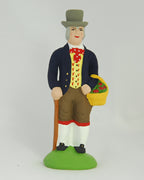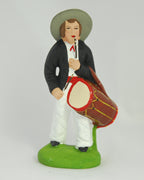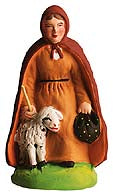History of Inge-Glas of Germany
The Inge-Glas Company has it's origins in the glass-blowing center of Lauscha, Germany, in the state of Thuringia, going back to the late 1500s. The company explains the Müller-Blech family's journey and it is a journey distinctly steeped in history:
- Renown originally for their bird ornaments - the number one figural ornament collected,
- Inge-Glas built a strong Christmas ornament business starting in the 1860s, but this was interrupted in 1951 with the Soviet occupation of Lauscha;
- they managed to move to Neustadt in then Western Germany during the Soviet period (Neustadt being just beyond the Soviet Eastern Germany border), and even maintained (a delicate situation), where possible, contact with family and glass-blowers in the East;
- they actively built an extensive collection of antique ornament moulds;
- charmingly, they strengthened that important collection with the marriage in the 1990s of 14th generation descendant Klaus Müller-Blech to Birgit Eichhorn-Jeremias-Sohn, also from a glassblowing family in Neustadt - resulting in a "marriage" of not only two glass-blowing artisans, but of their independent glass-blowing operations and antique moulds - presently some 6,000 strong;
- and, Inge-Glas has continued to work hard to keep their business strong by creating new moulds that appeal to today's customers and even more importantly to rejoice in the craftsmanship in Germany - where their ornaments are made to this day.
"Inge-Glas® has an impressive history, extending back to the late 1500s in the village of Lauscha, Germany where mouth glassblowing was a cottage industry. Every family had their own specialty and the Müller family was renown for their bird ornaments. Beginning in the 1860s the Müller family specifically customized their craft for creating Christmas ornaments. In 1951 the Russian occupation of Lauscha led 13th generation descendent Heinz Müller-Blech to flee to Neustadt, when in 1953 he and his wife Inge (from whom Inge-Glas® is named) reestablished what is now the modern day Inge-Glas® workshops. Heinz managed to smuggle several glassblowing moulds and after settling down in Neustadt he began to actively search for antique ornament moulds. His family in East Germany would send packages to him containing only halves of the moulds at a time so authorities would not confiscate them.
In the 1960s, Klaus Müller-Blech, 14th generation descendent, spent countless hours in the glass workshops of his parents to learn the profession. Klaus traveled to the U.S. in 1992 to attend the Golden Glow of Christmas Past Convention and to search for antique ornaments. Here he met his future wife, Birgit Eichhorn-Jeremias-Sohn, also from a family of glassblowers in Neustadt, Germany. The two lived in the same village in Germany and had never met until the U.S. convention! When the couple married their families combined their glassblowing operations and antique mould collections. The Müller-Blech family is now reintroducing ornaments made from some of the 6,000 antique moulds their families passed down through the generations. Not all moulds are Christmas oriented. A large portion of the line has year-round appeal for collectors."
"Essential" Santons for a Provençal Creche
We are proud to sell the Santons of the Marcel Carbonel Workshop in Marseille, Provence. The Carbonel Workshop is the Premiere creator of Santons.
 Click on the image above to find them in our shop.
Click on the image above to find them in our shop.
As one peruses the Santons literature, one discovers lists here and there of the specific Provençal characters vital to the creche. What makes the Santons creche so charming is that it is set not in Bethlehem, but rather in Provence. The nativity figures are in biblical dress. The additional creche figures typify characters found in an 18th or 19th century Provençal village, resulting in a year-in, year-out celebration of the area's history. The most authoritative list that we have found is from the book Provençal Figurines by C. Galtier and E. Cattin, translated by John Lee (Editions Ouest-France, 13 rue du Breil, Rennes, 1996). They make specific reference to "A Referendum for the Ideal Creche." Reportedly, L'Armana Prouvençau (a newspaper which we understand to be devoted to the preservation of the Provençal dialect and of all things Provençal) in 1968 published a list of 55 Santons (not including the basic nativity figures) from which they asked their readership to vote on which belonged in the "ideal creche."
L'Armana Prouvençau published the top 20 selected, with the number of votes received in the captions. The photos portray most of the figures in size #2. Almost all (or their equivalent) are available in all four sizes: Puce, #1, #2, and #3.
-




The Shepherd - le Berger (23,000 votes) The Delighted One - le Ravi (21,414) The Blind Man - l'Aveugle (16,734) The Old Folk - Les Vieux (16,704) 



The Knife Grinder - Le Remouler (16,476) The Miller - le Meunier (16,170) Roustido (14,820) Margarido (14,070) 



The Gypsy - le Bohémien (13,614) Pistachie - le Pistaché (12,237) Bartholomew - Bartoumiéu (10,476) Jourdan - Jourdan (10,145) 



The Tambourine-man - le Tambourinaire (10,122) The Fishwife - la Poissonniêre (9,937) The Hunter - le Chasseur (8,070) The Angler - le Pêcheur à la ligne (6,042) 



The Reeling-girl - la Fileuse
(5,640)Woman carrying Wood
la Porteuse de fagots (5,148)The Woman carrying Garlic - la Porteuse d'ail (4,188) The Shepherdess - la Bergère (3,432) - A variety of other lists of the "basic Santons" vital to the creche scene include:
-




The Baker - le Boulanger The Basketmaker - Vincent le vannier The Dairymaid -
LaitiêreThe Mayor - Monsieur le Maire 



The Parish Priest - Monsieur le curé The Washerwoman - Bugadière The Woman with a Cradle - Femme au Berceau The Woman with a Rabbit - Femme au lapin
An interesting observation is that in my research I discovered a number of sources that suggested that there were "55 essential figures to the basic Santons nativity." This statement exists in several renown French guide books. I have the feeling that the "55" figure is mistakenly derived from Galtier's book, where he quotes L'Armana Prouvençeau and the fact that in doing their survey they provided a list of 55 Santons from which they asked their readership to select the 20 most ideal. If you know otherwise, we would appreciate your comments. We would also be interested in hearing from you regarding which figures you feel are essential.
The savoring of the greens
The putting away of Christmas is a thoughtful time - the extended family has returned to their respective homes and we settle down to embracing the work of 2012. As the ornaments are removed and the tree finds a new home on the edge of the yard, we once again reminisce each ornament's history and receive pleasure in knowing that the tree returns to being shelter for the birds. Somehow, even in retirement, we establish new traditions. This year, for the first time, it was the family botanist who placed the greens, tucking them in here and there around our home. They are so artfully placed it is difficult to want to remove them, even with the thought of saying goodbye to the holiday and enjoying the process of "sweeping clean" for the New Year.

We were ever so pleased to have been researching Candlemas, and to have found a reference to the fact that Candlemas, February 2nd, is not only a Christian commemoration of the presentation of Jesus at the Temple, a festival of lights celebrating the half-way point between the winter solstice and the spring equinox (in particular the strengthening of the life-giving force of the sun), but also a designated day for the putting away of the greens of Christmas.


And thus we shall wait. We shall savor the continuing presence of the greens. We do admit that one of the happiest parts of Christmas is bringing the tree into the house--we often reflect as it happens that we don't actually need lights and decorations, that just having the tree inside is perfection, in fact one large perfection in a series of holiday perfections that make the season so meaningful. Now we have something new to look forward to, adding this tradition plus a small celebration of Candlemas on February 2nd. Life is good!
Three Kings Day - Epiphany - January 6 - Santons
Epiphany, the twelfth and final day of Christmas, the day of the Three Kings (the Wise Men or Magi - Caspar, Melchior, and Balthasar) rests on January 6th in the Western world. It is on the twelfth day of Christmas that the Three Kings reach Jesus in Bethlehem. January 6th commemorates the coming of the Magi and the presence of Christ in the world.
In the world of Santons, the coming of Mary and Joseph to the Stable, the arrival of Jesus, and then the arrival of the Three Kings are all celebrated. The Carbonel Santons workshop offers distinct figures for the advent of Mary and Joseph in their Size #2, Elite Santons.
When the nativity is set-up in a family's home they first place Advent Mary and Joseph at a distinct distance from the stable and move them closer day by day.
On Christmas Eve the Advent Set is put away and the Kneeling Mary and Joseph are placed in the creche.
Christmas morning, of course, the Christ Child arrives.
And then the three Kings commence their journey, beginning in a spot distant from the creche, and then as with Advent Mary and Joseph, move a little bit closer each day, finally arriving in Bethlehem at the stable on January 6 to rejoice in Christ's birth.












































